
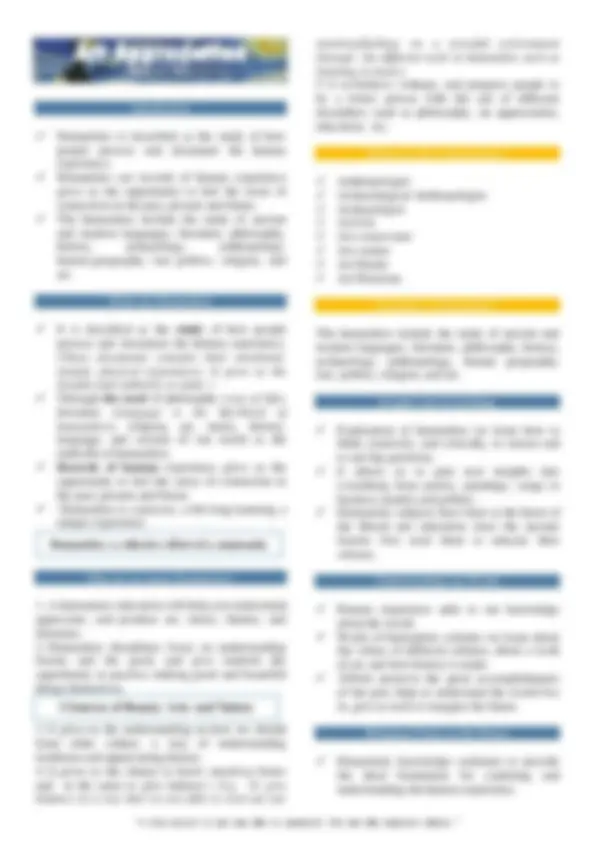
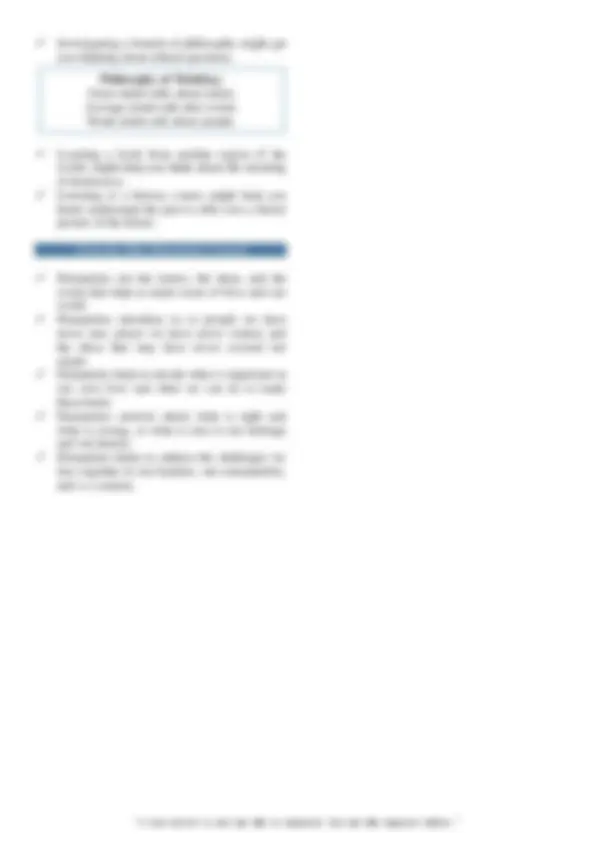
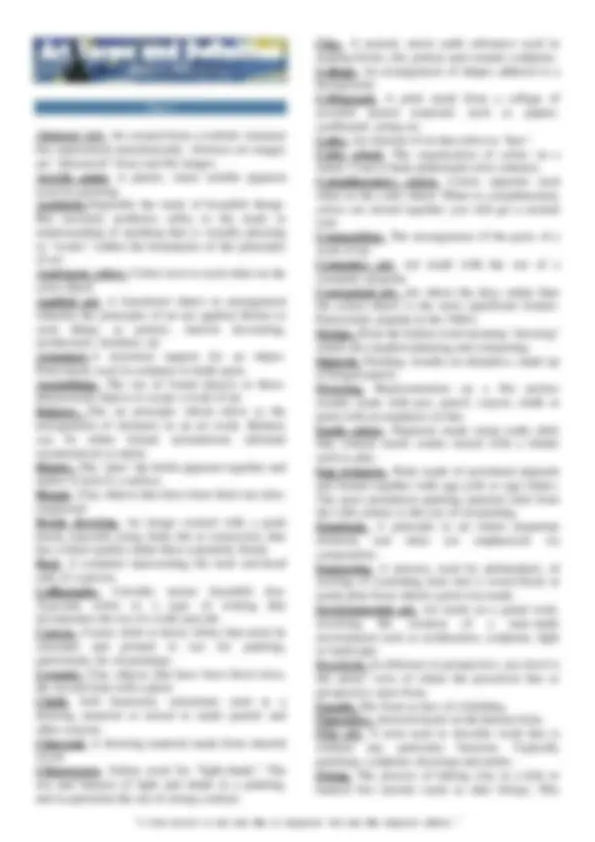
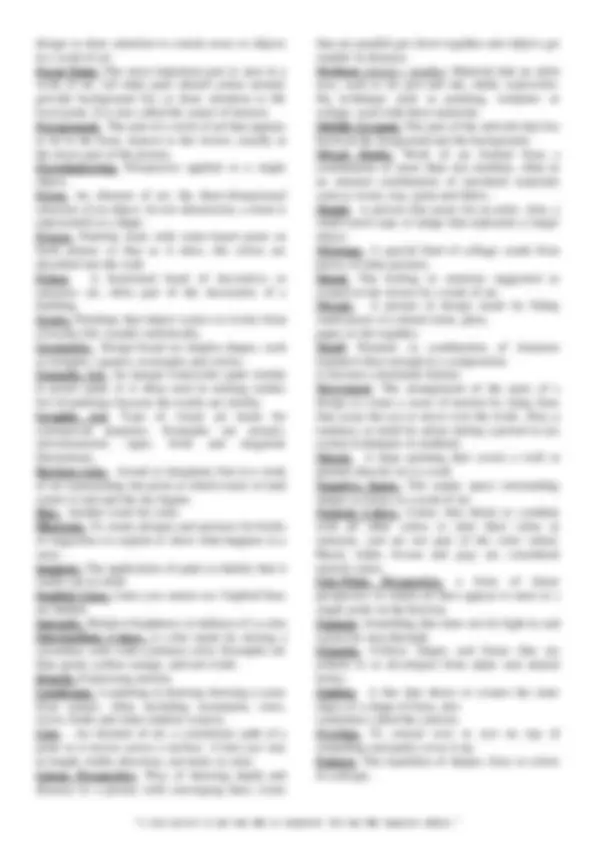
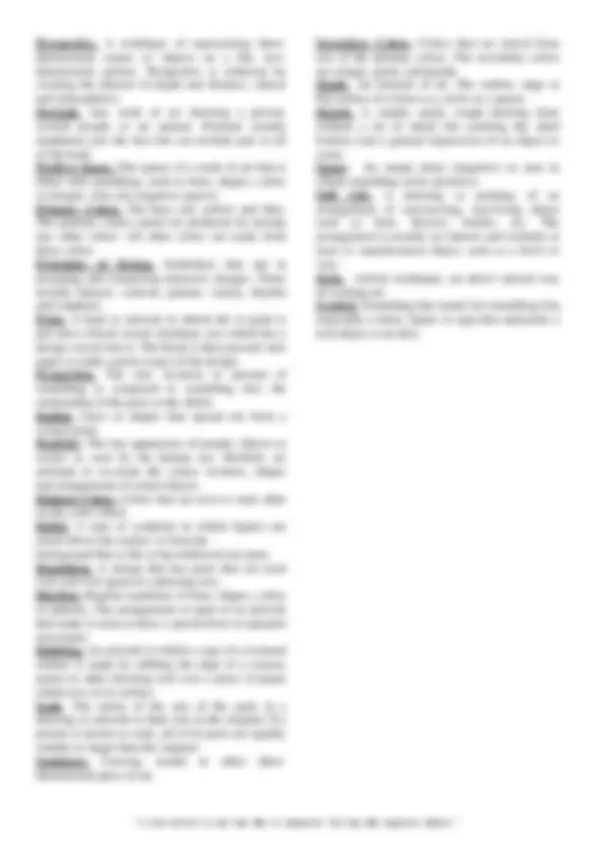
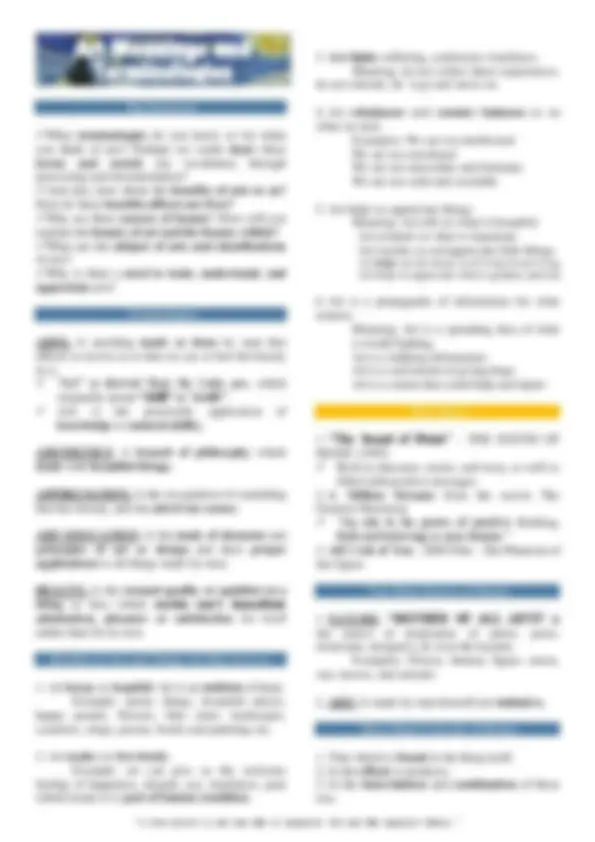
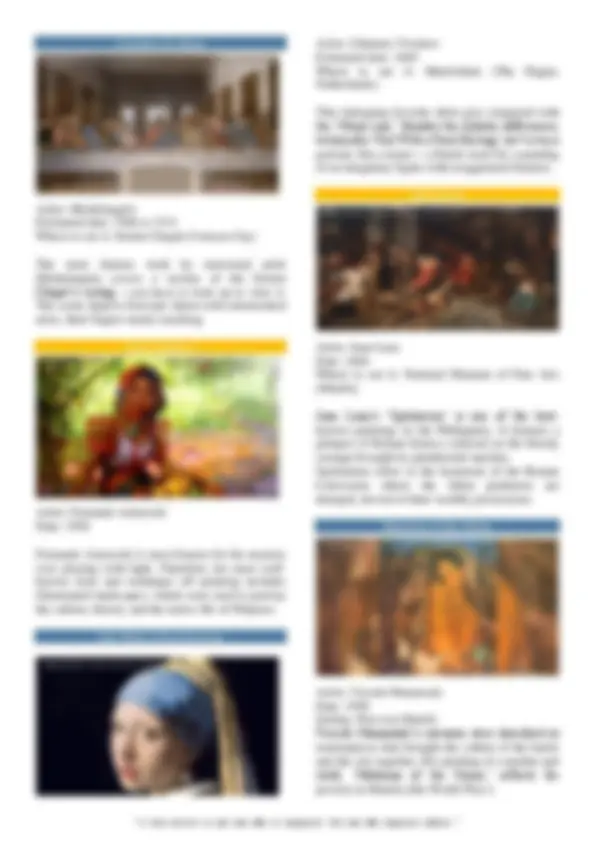

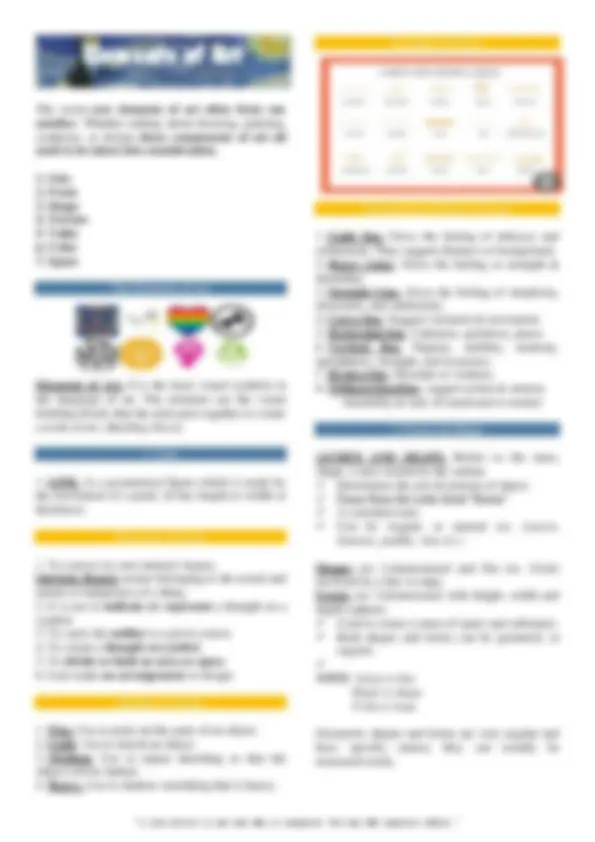


Study with the several resources on Docsity

Earn points by helping other students or get them with a premium plan


Prepare for your exams
Study with the several resources on Docsity

Earn points to download
Earn points by helping other students or get them with a premium plan
Community
Ask the community for help and clear up your study doubts
Discover the best universities in your country according to Docsity users
Free resources
Download our free guides on studying techniques, anxiety management strategies, and thesis advice from Docsity tutors
Explore the world of art through this three-unit course that develops your ability to appreciate, analyze, and critique works of art. Learn about artistic principles and theories, and discover how art can be used for self-expression and cultural exploration. the functions, value, and historical significance of art, as well as various art genres and techniques.
What you will learn
Typology: Transcriptions
1 / 17

This page cannot be seen from the preview
Don't miss anything!










March 8, 2022 Background of the Subject About the Course ✓ Art Appreciation is a three unit course that develops student’s ability to appreciate, analyse, and critique works of art. ✓ Through interdisciplinary and multi-modal approaches, this course equips students with a broad knowledge of the practical, historical, philosophical, and social relevance of the arts in order to hone their ability to articulate their understanding of the arts. ✓ This course also develops students’ competency in researching and curating art as well as in conceptualizing, mounting, and evaluating art productions. ✓ It also aims to develop students’ genuine appreciation for the Philippine arts by providing them opportunities to explore the diversity and richness and their rootedness in Filipino culture. At the end of the course Knowledge
Instructor’s Contact Information and Schedule Email address: al.benzon@unp.edu.ph Website : www.unp.edu.ph Modes: (cellphone, email, messenger, viber, and others). Check your schedule (enrollment form/white form). The Grading System 1.0 97 - 100 1.25 94 - 96 1.5 91 - 93 1.75 88 - 90 2.0 85 - 87 2.25 82 - 84 2.5 80 - 81 2.75 78 - 79 3.0 75 - 77 5.0 failed Grading of Outputs: ✓ All areas below must be satisfactory in order to pass the course: 70% Related Tasks 30% Midterm and Final Exam General Class Policies
Philosophy of Thinkin g: Great minds talks about ideals. Average minds talk abut events. Weak minds talk about people. ✓ Investigating a branch of philosophy might get you thinking about ethical questions. ✓ Learning a book from another region of the world, might help you think about the meaning of democracy. ✓ Listening to a history course might help you better understand the past to offer you a clearer picture of the future. From the Ohio Humanities Council ✓ Humanities are the stories, the ideas, and the words that help us make sense of lives and our world. ✓ Humanities introduce us to people we have never met, places we have never visited, and the ideas that may have never crossed our minds ✓ Humanities help us decide what is important in our own lives and what we can do to make them better ✓ Humanities answers about what is right and what is wrong, or what is true to our heritage and our history. ✓ Humanities helps us address the challenges we face together in our families, our communities, and a s a nation.
Art Terms and Definition (March 22, 2022) Part I Abstract Art. Art created from a realistic situation but represented unrealistically. Abstract art images are "abstracted" from real life images Acrylic paint. A plastic, water soluble pigment used for painting. Aesthetic. Originally the study of beautiful things. But currently aesthetics refers to the study or understanding of anything that is visually pleasing or "works" within the boundaries of the principles of art. Analogous colors. Colors next to each other on the color wheel. Applied art. A functional object or arrangement whereby the principles of art are applied. Refers to such things as pottery, interior decorating, architecture, furniture, etc Armature. A structural support for an object. Particularly used in sculpture to build upon. Assemblage. The use of found objects or three- dimensional objects to create a work of art. Balance. The art principle which refers to the arrangement of elements in an art work. Balance can be either formal symmetrical, informal asymmetrical or radial. Binder. The "glue" the holds pigment together and makes it stick to a surface. Bisque. Clay objects that have been fired one time. (unglazed) Brush drawing. An image created with a paint brush, typically using India ink or watercolor, that has a linear quality rather than a painterly finish. Bust. A sculpture representing the neck and head only of a person. Calligraphy. Literally means beautiful line. Typically refers to a type of writing that incorporates the use of a wide pen nib. Canvas. Coarse cloth or heavy fabric that must be stretched and primed to use for painting, particularly for oil paintings. Ceramic. Clay objects that have been fired twice, the second time with a glaze. Chalk. Soft limestone, sometimes used as a drawing material or mixed to make pastels and other crayons. Charcoal. A drawing material made from charred wood. Chiaroscuro. Italian word for "light-shade". The use and balance of light and shade in a painting, and in particular the use of strong contrast. Clay. A natural, moist earth substance used in making bricks, tile, pottery and ceramic sculpture. Collage. An arrangement of shapes adhered to a background. Collagraph. A print made from a collage of assorted pasted materials such as papers, cardboards, string etc. Color. An element of art that refers to "hue". Color wheel. The organization of colors on a wheel. Used to help understand color schemes. Complimentary colors. Colors opposite each other on the color wheel. When to complimentary colors are mixed together you will get a neutral tone Composition. The arrangement of the parts of a work of art. Computer art. Art made with the use of a computer program. Conceptual art. Art where the idea, rather than the actual object is the most significant feature. Particularly popular in the 1960's. Design. From the Italian word meaning "drawing" which also implied planning and composing. Diptych. Painting, usually an altarpiece, made up of hinged panels. Drawing. Representations on a flat surface usually made with pen, pencil, crayon, chalk or paint with an emphasis on line. Earth colors. Pigments made using earth (dirt) that contain metal oxides mixed with a binder such as glue. Egg tempera. Paint made of powdered pigment and bound together with egg yolk or egg whites. The most prominent painting material used from the 12th century to the rise of oil painting. Emphasis. A principle in art where important elements and ideas are emphasized via composition. Engraving. A process, used by printmakers, of incising or scratching lines into a wood block or metal plate from which a print was made. Environmental art. Art made on a grand scale, involving the creation of a man-made environment such as architecture, sculpture, light or landscape. Eye-level. In reference to perspective, eye-level is the artists' view of where the perceived line or perspective came from. Facade. The front or face of a building. Figurative. Artwork based on the human form. Fine art. A term used to describe work that is without any particular function. Typically paintings, sculpture, drawings and prints. Firing. The process of baking clay in a kiln or banked fire outside (such as raku firing). This
Secondary colors. Orange, green and purple. Shade. Refers to the darker values of a color. Shape. The element of art that describes a two- dimensional area (height and width). Sketch. Preliminary or rough draft, typically made with pencil, crayon, pen, brush or pastel. Slip. Dried, crushed clay mixed with water to a creamy consistency. Used as a binder in joining two pieces of clay together. Still life. Inanimate object(s) represented in a drawing, painting or collage. Tempera paint. An opaque, water soluble paint available in liquid or powdered form. Texture. The quality of a surface. One of the seven elements of art. Tint. A hue mixed with white to create lighter values. Tone. The amount of light or shade in a color. The value range in a painting. Value. The range of lightness or darkness in a color. A gray scale shows the range of values in photography. Watercolors. Pigment with a water soluble binder. Available in semi-moist cakes or tubes. Wedging. A method of preparing clay by kneading and squeezing it to expel air pockets and make it more plastic. Part II Abstract. A style of art in which shapes, designs, textures and colors are represented in a way that may look unrealistic, but that emphasizes moods or feelings. Abstract art is characterized by the use of geometric lines and shapes and bright, bold colors. Aesthetic. Pertaining to the artistic and beautiful, a perception that something is pleasing to the eye. Analogous Colors. Colors that are closely related. For example, blue, blue-violet and violet all have the color blue in common. Asymmetrical. Having a kind of balance in which the two sides of an artwork are not exactly alike, but still look balanced. Background. The parts of an artwork that lie in the distance and appear to be behind objects in the foreground. Balance. A principle of design. The arrangement of elements in a work of art (including size and number of objects) that achieves a sense of equality. Bird's Eye View. A scene shown from high up in the air as a bird in flight might see it. Brush stroke. A line, shape or texture created by applying paint to a surface with a paintbrush in a particular way. Calligraphy. T he art of writing letters and words in an ornamental style using brushes or pens. Collage. Work of art created by gluing bits of paper, fabric, scraps, photographs or other materials to a flat surface. Color. An element of art. The hue, value, and intensity of an object. The primary colors are red, blue and yellow: every color except white can be created from various blending of these three colors. Color Wheel. A circle divided into sections of different colors. It shows how colors can be mixed or used together. Complementary Colors. Colors that are opposite on the color wheel and contrast with each other. For example, orange is the compliment blue, yellow, of purple and red of green. Composition. Arrangement or design of elements of an artwork to achieve balance, contrast rhythm, emphasis and unity to make an effective expression of an artist's idea. The term also refers generally to any work of art. Contrast. A large difference between two things; for example, warm and cool, yellow and purple, light and shadow. Contrasting values, colors and textures add excitement, emphasis and interest to a work of art. Cool Colors. The family of related or analogous colors ranging from the greens through the blues and violets. They remind people of cool places, things and feelings. Depth. The apparent distance from front to back or near to far in a work of art. Techniques of perspective are used to create the illusion of depth in a two-dimensional painting. Design. To plan and arrange all the parts of an artwork. Also, an organized and creative arrangement of the elements in a work of art. Detail. A distinctive feature of an object or scene which can be seen most clearly close up. Also, a small part of a work of art, enlarged to show a close-up of its features. Dominant. The part of a design that is the most important, powerful or has the most influence. A certain color can be dominant, and so can anobject, line, shape or texture. Elements of Art. Basic components which are put together to make a visual work of art. They are color, line, shape, texture, space, form and value. All works of art are composed of these basic elements. Emphasis. The use of sizes, shapes, colors, textures and other elements and principles of
design to draw attention to certain areas or objects in a work of art. Focal Point. The most important part or area in a work of art. All other parts should center around, provide background for, or draw attention to the focal point. It is also called the center of interest. Foreground. The part of a work of art that appears to be in the front, nearest to the viewer, usually in the lower part of the picture. Foreshadowing. Perspective applied to a single object. Form. An element of art; the three-dimensional structure of an object. In two dimensions, a form is represented as a shape. Fresco. Painting done with water-based paint on fresh plaster so that as it dries, the colors are absorbed into the wall. Frieze. A horizontal band of decorative or narrative art, often part of the decoration of a building. Genre. Paintings that depict scenes or events from everyday life, usually realistically. Geometric. Design based on simples shapes, such as triangles, squares, rectangles and circles. Gouache Art. An opaque watercolor paint similar to poster paint. It is often used in making studies for oil paintings because the results are similar. Graphic Art. Type of visual art made for commercial purposes. Examples are posters, advertisements, signs, book and magazine illustrations. Horizon Line. Actual or imaginary line in a work of art representing the point at which water or land seems to end and the sky begins. Hue. Another word for color. Illustrate. To create designs and pictures for books or magazines to explain or show what happens in a story. Impasto. The application of paint so thickly that it stands out in relief. Implied Lines. Lines you cannot see. Implied lines are hidden. Intensity. Relative brightness or dullness of a color. Intermediate Colors. A color made by mixing a secondary color with a primary color. Examples are blue-green, yellow-orange, and red-violet. Kinetic. Expressing motion. Landscape. A painting or drawing showing a scene from nature; often including mountains, trees, rivers, fields and other outdoor scenery. Line.. An element of art; a continuous path of a point as it moves across a surface. A line can vary in length, width, direction, curvature or color. Linear Perspective. Way of showing depth and distance in a picture with converging lines. Lines that are parallel get closer together and objects get smaller in distance. Medium (plural – media). Material that an artist uses, such as oil, pen and ink, chalk, watercolor: the technique such as painting, sculpture or collage, used with these materials. Middle Ground. The part of the artwork that lies between the foreground and the background. Mixed Media. Work of art formed from a combination of more than one medium, often in an unusual combination of unrelated materials such as wood, clay, paint and fabric. Model. A person who poses for an artist. Also, a small-sized copy or image that represents a larger object. Montage. A special kind of collage, made from pieces of other pictures. Mood. The feeling or emotion suggested or created in the viewer by a work of art. Mosaic. A picture or design made by fitting small pieces or colored stone, glass, paper or tile together. Motif. Element or combination of elements repeated often enough in a composition to become a dominant feature. Movement. The arrangement of the parts of a design to create a sense of motion by using lines that cause the eye to move over the work. Also,-a tendency or trend by artists during a period to use certain techniques or methods. Mural. A large painting that covers a wall or painted directly on to a wall. Negative Space. The empty space surrounding shapes or forms in a work of art. Neutral Colors. Colors that blend or combine with all other colors to alter their value or intensity, and are not part of the color wheel. Black, white, brown and gray are considered neutral colors. One-Point Perspective. a form of linear perspective in which all lines appear to meet at a single point on the horizon. Opaque. Something that does not let light in and cannot be seen through. Organic. Utilizes shapes and forms that are related to or developed from plant and animal forms. Outline. A line that shows or creates the outer edges of a shape of form, also sometimes called the contour. Overlap. To extend over or rest on top of something and partly cover it up. Pattern. The repetition of shapes, lines or colors in a design.
Art Meanings and Terminologies Big Questions ✓ What terminologies do you know so far when you think of arts? Perhaps we could s hare these terms and enrich our vocabulary through processing and documentation? ✓ And also, how about the benefits of arts to us? How do these benefits affects our lives? ✓ Why are there sources of beauty? How will you explain the beauty of art and the beauty within? ✓ What are the subject of arts and classifications of arts? ✓ Why is there a need to train, understand, and appreciate arts? Terminologies ARTS. Is anything made or done by man that affects or moves us to that we see or feel the beauty in it. ✓ “Art” is derived from the Latin ars , which originally meant “skill” or “ craft.” ✓ Arts is the practically application of knowledge or natural ability. ASETHETICS. A branch of philosophy which deals with beautiful things. APPRECIATION. Is the recognition of something that has beauty, and the aid of our senses. ART EDUCATION. Is the study of elements and principles of art or design and their proper applications to all things made by man. BEAUTY. Is the sensual quality or qualities in a thing or idea which excites one’s immediate admiration, pleasure or satisfaction for itself rather than for its uses. Benefits of Arts and Things Art May do to us
The Need for Training Individuals to Understand & Appreciate Arts
1. Art is a part of man’s daily life.
Creation of Adam Artist: Michelangelo Estimated date: 1508 to 1512 Where to see it: Sistine Chapel (Vatican City) The most famous work by renowned artist Michelangelo covers a section of the Sistine Chapel’s ceiling – you have to look up to view it. The scene depicts God and Adam with outstretched arms, their fingers nearly touching. Fruit Gatherer Artist: Fernando Amorsolo Date: 1950 Fernando Amorsolo is most famous for his mastery over playing with light. Therefore, his most well- known style and technique off painting includes illuminated landscapes, which were used to portray the culture, history and the native life of Filipinos Girl With A Pearl Earring Artist: Johannes Vermeer Estimated date: 1665 Where to see it: Mauritshuis (The Hague, Netherlands) This intriguing favorite often gets compared with the ‘Mona Lisa.’ Besides the stylistic differences, technically ‘Girl With a Pearl Earring’ isn’t even a portrait, but a tronie – a Dutch word for a painting of an imaginary figure with exaggerated features. Spoliarium Artist: Juan Luna Date: 1884 Where to see it: National Museum of Fine Arts (Manila) Juan Luna’s ‘Spoliarium’ is one of the best- known paintings in the Philippines. It features a glimpse of Roman history centered on the bloody carnage brought by gladiatorial matches. Spoliarium refers to the basement of the Roman Colosseum where the fallen gladiators are dumped, devoid of their worldly possessions. Madonna of the Slums Artist: Vicente Manansala Date: 1950 Setting: Post-war Manila Vicente Manansala’s canvases were described as masterpieces that brought the culture of the barrio and the city together. His painting of a mother and child, ‘Madonna of the Slums,’ reflects the poverty in Manila after World War 2.
La Laguna Estigia Artist: Felix Resurreccion Hidalgo Date: 1887 English Title: The River Styx ‘La Laguna Estigia’ is based on Dante Alighieri’s 14 th^ century epic poem Inferno,where hell is depicted having nine concentric circles which represent the different sins. The fifth circle of Hell, which is known as Wrath, is located in the stinking water of the River Styx.
Psychological Effects of Forms